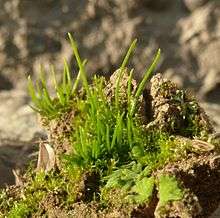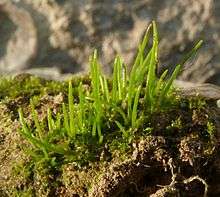Anthoceros agrestis
Anthoceros agrestis, commonly called field hornwort,[2] is a bryophyte of the genus Anthoceros. It has complicated taxonomies.
| Anthoceros agrestis | |
|---|---|
 | |
| Anthoceros agrestis in Schwäbisch-Fränkische Waldberge, Deutschland. | |
| Scientific classification | |
| Kingdom: | Plantae |
| Division: | Anthocerotophyta |
| Class: | Anthocerotopsida |
| Order: | Anthocerotales |
| Family: | Anthocerotaceae |
| Genus: | Anthoceros |
| Species: | A. agrestis |
| Binomial name | |
| Anthoceros agrestis (Paton) Damsholt | |
| Synonyms[1] | |
| |
Taxonomy

This species of Anthoceros is known for having enzymes like cinnamic acid 4-hydroxylase (EC 1.14.13.11), a cytochrome P450-dependent hydroxylase. Cinnamic acid 4-hydroxylase (C4H; EC 1.14.13.11) is one of the first known plant cytochrome P450 monooxygenases[3] and also one of the best-characterized cytochrome P450 hydroxylases from higher plants.[4][5]
Description
Anthoceros agrestis grows as a thin, dark green, rosette-like thallus up to 1.5 cm (0.6 in) in diameter, superficially resembling a leafless liverwort. The surface is punctured with hollows containing the male organs. The spore-producing bodies lack a stalk or capsule but produce erect, cylindrical structures that turn black as they mature. They then split open to reveal the spore-bearing central spindle and release the black spores.[6]
Distribution and habitat
This hornwort has a circum-boreal distribution across temperate Europe and North America.[7] It is a lowland species found in moist soil in arable fields and ditches. It is listed as vulnerable in the Irish Red Data Book as it is known from fewer than five locations in the country. It occurs at a single location in Northern Ireland, in County Down, and because of its rarity there, it is listed as a Northern Ireland Priority Species.[6]
Chemistry
Production of Rosmarinic acid and a rosmarinic acid 3'-O-beta-D-glucoside in suspension cultures of this hornwort was also discovered in 2005.[8]
Anthocerodiazonin, an alkaloid, was isolated from in vitro cultures of the species. Also, six glutamic acid amides, N-(4-hydroxybenzoyl)-glutamic acid, N-(3,4-dihydroxybenzoyl)-glutamic acid, N-(4-hydroxy-3-methoxybenzoyl)-glutamic acid, (E)-N-(isoferuloyl)-glutamic acid, (Z)-N-(isoferuloyl)-glutamic acid and (Z)-N-(p-coumaroyl)-glutamic acid were obtained as natural products.[9]
References
- "Anthoceros agrestis Paton var. agrestis". Flora of North America. USDA. Retrieved 11 March 2020.
- Edwards, Sean R. (2012). English Names for British Bryophytes. British Bryological Society Special Volume. 5 (4 ed.). Wootton, Northampton: British Bryological Society. ISBN 978-0-9561310-2-7. ISSN 0268-8034.
- Russell and Conn 1967, Russell 1971
- Werck-Reichhardt 1995
- Petersen, M. (18 January 2003). "Cinnamic acid 4-hydroxylase from cell cultures of the hornwort Anthoceros agrestis". Planta. 217 (1): 96–101. doi:10.1007/s00425-002-0960-9. PMID 12721853.
- Hodgetts, Nick. "Anthoceros agrestis – field hornwort". Northern Ireland Priority Species. Retrieved 11 March 2020.
- "Anthoceros agrestis". University of New Brunswick. Retrieved 11 March 2020.
- Vogelsang, K.; Schneider B.; Petersen M. (20 August 2005). "Production of rosmarinic acid and a new rosmarinic acid 3'-O-beta-D-glucoside in suspension cultures of the hornwort Anthoceros agrestis Paton". Planta. 223 (2): 369–73. doi:10.1007/s00425-005-0089-8. PMID 16133208.
- Becker, H.; Burkharda G.; Trennheuser F. (3 February 1994). "Anthocerodiazonin an alkaloid from Anthoceros agrestis". Phytochemistry. 37 (3): 899–903. doi:10.1016/S0031-9422(00)90380-7.